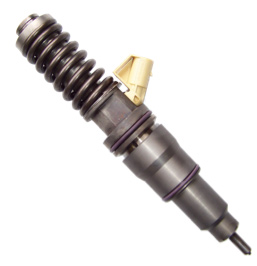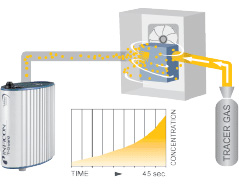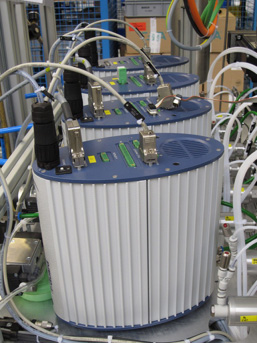Controllo fughe su iniettori di benzina
Description of Technical Challenge

Fuel injectors must withstand increasing pressures and need to be leak tested for smaller and smaller leakage.
Cost pressure in the automobile and supply industries is high. At the same time, the need to reduce fuel consumption is increasing the pressure of injected fuel, thus the leak rate of the injector increases due to the application pressure increasing. To remain competitive, production and delivery processes must always be further optimized. At the same time, the demands pertaining to safety, quality, and environmental compatibility continue to increase. To overcome these obstacles, every component must be thoroughly inspected in accordance with certain criteria, yet without testing becoming a factor that drives up the costs of serial production. Traditionally vacuum leak testing has been the method of choice for testing fuel injectors. However, the investment and operating costs for these test systems are quite high. For fuel injector testing, the cost-benefit ratio is not optimal and the test technology is simply over-dimensioned, both in terms of space requirements and sensitivity. Typical leak rate requirements are in the 10-4 mbarl/s range (helium leak rate) - equivalent to 0.006 sccm. Vacuum leak detection systems can detect leaks down to the 10-10... 10-11 mbarl/s range.
The INFICON Solution
Today leak detection with helium in an accumulation chamber under atmospheric pressure (accumulation method) offers an economical solution for leak testing of fuel injectors.

Leak testing fuel injectors in accumulation systems with the T-Guard Helium Sensor offers a fast, economic and reliable alternative.
In a simple chamber, the test part is pressurized allowing the test gas to escape through any leaks into the accumulation chamber. Fans then ensure an even distribution of the test gas in the chamber – so, independent of the position of the leak, precise measurement values are guaranteed. The T-Guard Helium Accumulation Sensor then determines the test gas content in this atmosphere.
With this method, leaks in the neighborhood of 10-4... 10-5 mbar l/s can be confidently verified. The system is also not affected by heat and moisture on the test pieces or in the environment. In addition, one can test parts that do not tolerate vacuum conditions, such as when components are made of slightly outgassing plastics.
Typical cycle times are in the range of 5 - 10 s.
![]() MR. MICHAEL URHAHN, DEVELOPMENT ENGINEER AT BOSCH PA –ATMO, FEUERBACH, GERMANY
MR. MICHAEL URHAHN, DEVELOPMENT ENGINEER AT BOSCH PA –ATMO, FEUERBACH, GERMANY
“We were able to decrease the cost and time involved and to significantly increase the productivity of the Bamberg production line. A comparable vacuum system would have been much more expensive, just even in terms of the procurement costs. In addition, the energy consumption is eight times lower and the technical availability is substantially higher than before.”
| Performance Data of Four-Fold T-Guard Test System at Bosch | |
|---|---|
| Part tested: | Bi-Fuel injectors |
| Chamber volume: | 1 liter |
| Cycle time: | 5.6 sec |
| Leakage rate: | 4 x 10-4 mbarl/s |

The four-fold T-Guard system at Bosch can test one fuel injector every 6 seconds.
Benefits of Leak Testing with the T-Guard Helium Accumulation Sensor
- Accurate and repeatable measurements for reliable results of leak testing
- Lower investment cost, more cost efficient leak testing
- Less production space needed
- Lower energy consumption (< 15%)
- Time saving, as also warm and wet/humid parts may be tested
- Decreased cycle time, increased productivity
- Less maintenance required, higher uptime and availability